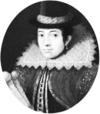- Pocahontas
-
/poh'keuh hon"teuhs/, n.(Rebecca Rolfe) 1595?-1617, American Indian woman who is said to have prevented the execution of Captain John Smith.
* * *
died March 1617, Gravesend, Kent, Eng.Pocahontas helped maintain peace between English colonists and Native Americans by befriending the settlers at Jamestown, Va. Daughter of the powerful chief Powhatan, Pocahontas intervened to spare the life of the colony's captive leader, John Smith. She subsequently converted to Christianity and wedded the colonist John Rolfe, which furthered efforts toward peace. She traveled to England, where she was received at court, but she died of smallpox there. Pocahontas, detail of a portrait by an unknown artist, 1616.Library of Congress, Washington, D.C.
Pocahontas, detail of a portrait by an unknown artist, 1616.Library of Congress, Washington, D.C.* * *
▪ Powhatan princessborn c. 1596, near present-day Jamestown, Virginia, U.S.died March 1617, Gravesend, Kent, EnglandPowhatan Indian woman who fostered peace between English colonists and Native Americans by befriending the settlers at the Jamestown Colony in Virginia and eventually marrying one of them.Among her several native names, the one best known to the English was Pocahontas (translated at the time as “little wanton” or “mischievous one”). She was a daughter of Powhatan (as he was known to the English; he was also called Wahunsenacah), chief of the Powhatan empire, which consisted of some 28 tribes of the Tidewater region. Pocahontas was a young girl of age 10 or 11 when she first became acquainted with the colonists who settled in the Chesapeake Bay area in 1607.By the account of colonial leader John Smith (Smith, John), she interceded to save Smith's life in December of that year, after he had been taken prisoner by her father's men. Smith wrote that, when he was brought before Powhatan, Pocahontas halted Smith's execution by placing herself over him as he was about to have his head clubbed on a stone. Powhatan released Smith to return to Jamestown. Some writers have theorized that Smith may have misunderstood what he saw and that what he believed to be an execution was instead a benign ceremony of some kind; others have alleged that he invented the rescue outright.What is known is that Pocahontas became a frequent visitor to the settlement and a friend of Smith. Her playful nature made her a favourite, and her interest in the English proved valuable to them. She sometimes brought gifts of food from her father to relieve the hard-pressed settlers. She also saved the lives of Smith and other colonists in a trading party in January 1609 by warning them of an ambush.After Smith's return to England in late 1609, relations between the settlers and Powhatan deteriorated. The English informed Pocahontas that Smith had died. She did not return to the colony for the next four years. In the spring of 1613, however, Sir Samuel Argall (Argall, Sir Samuel) took her prisoner, hoping to use her to secure the return of some English prisoners and stolen English weapons and tools. Argall did so by conspiring with Japazeus, the chief of the Patawomeck tribe, who lived along the Potomac River and whom Pocahontas was visiting. Japazeus and his wife lured Pocahontas onto Argall's ship, where Argall kept her until he could bring her to Jamestown. Although her father released seven English prisoners, an impasse resulted when he did not return the weapons and tools and refused to negotiate further.Pocahontas was taken from Jamestown to a secondary English settlement known as Henricus. Treated with courtesy during her captivity, Pocahontas was converted to Christianity and was baptized Rebecca. She accepted a proposal of marriage from John Rolfe (Rolfe, John), a distinguished settler; both the Virginia governor, Sir Thomas Dale, and Chief Powhatan agreed to the marriage, which took place in April 1614. Following the marriage, peace prevailed between the English and the Indians as long as Powhatan lived. According to the account of one colonist, Pocahontas had previously been married to a Powhatan man named Kocoum.In the spring of 1616, Pocahontas, her husband, their one-year-old son Thomas, and a group of other Native Americans, men and women, sailed with Governor Dale to England. There she was entertained at royal festivities. The Virginia Company apparently saw her visit as a device to publicize the colony and to win support from King James I and investors. While preparing to return to America, Pocahontas fell ill, probably with lung disease. Her illness took a turn for the worse and interrupted her return voyage before her ship left the River Thames. She died in the town of Gravesend at about age 21 and was buried there on March 21, 1617. Afterward her husband immediately returned to Virginia; her son remained in England until 1635, when he went to Virginia and became a successful tobacco planter.David A. PriceAdditional ReadingThere have been many fictionalized tellings of Pocahontas's story. Factual accounts of her life and times include David A. Price, Love and Hate in Jamestown: John Smith, Pocahontas, and the Heart of a New Nation (2003); and Philip L. Barbour, Pocahontas and Her World (1970). The role of Pocahontas's life story in American art, drama, and literature is considered in Robert S. Tilton, Pocahontas: The Evolution of an American Narrative (1994).* * *
Universalium. 2010.
